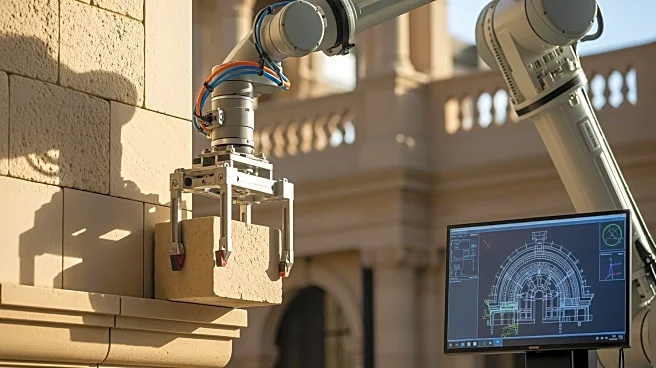What's Happening?
A new workflow integrating CAD and extended robotics has been developed to enhance the restoration of historic and heritage buildings (HHBs). This approach was tested on a deteriorated masonry screen wall
in Lanxi City, China, demonstrating its effectiveness in real-world conditions. The process involves several phases, including 3D reconstruction using photogrammetry and Kinect scanning, brick detection with the YOLACT algorithm, and digital modeling for accurate restoration planning. The workflow employs a volumetric design approach and the Wave Function Collapse (WFC) algorithm to ensure the digital model adheres to realistic structural principles. The final step involves Finite Element Analysis (FEA) to validate the structural integrity of the restored model.
Why It's Important?
This development is significant for the preservation of historic architecture, offering a scalable and precise method for restoring heritage buildings. By combining digital and physical restoration techniques, the workflow addresses the challenges of material decay and structural asymmetries inherent in heritage sites. The integration of robotics and CAD not only improves the accuracy and efficiency of restoration projects but also ensures the structural stability of restored buildings. This approach could revolutionize the field of heritage conservation, providing a model for future projects and potentially reducing costs and time associated with traditional restoration methods.
What's Next?
The successful implementation of this workflow suggests potential for broader application in heritage conservation. Future steps may include refining the technology for use in different types of structures and expanding its use to other regions. Stakeholders in the field of architecture and conservation may explore partnerships to further develop and implement this technology. Additionally, the integration of more advanced robotics and AI could enhance the precision and adaptability of the restoration process, paving the way for more complex projects.
Beyond the Headlines
The use of advanced technology in heritage restoration raises questions about the balance between preserving original craftsmanship and employing modern techniques. While the digital approach offers precision and efficiency, it may also lead to debates about authenticity and the role of human artisanship in restoration. Furthermore, the reliance on technology necessitates considerations of data security and the potential for technological obsolescence, which could impact long-term conservation efforts.











